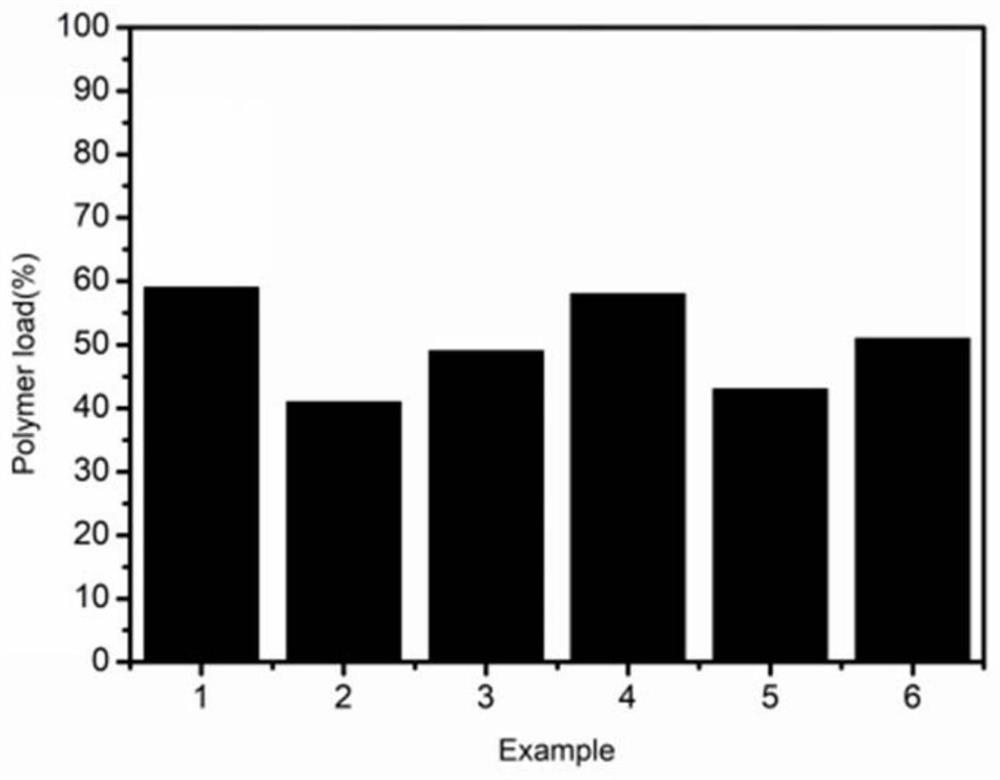Method for preparing environment-responsive polymers by composite assembly
A responsive polymer technology, which is applied in the field of magnetic field responsive polymers for cement concrete, can solve unreported problems and achieve broad application prospects
- Summary
- Abstract
- Description
- Claims
- Application Information
AI Technical Summary
Problems solved by technology
Method used
Image
Examples
Embodiment 1
[0032] First, 30g of styrene-propylene and 90g of dimethylformamide were added to the reactor, stirred and heated to 90°C, filled with nitrogen for 5 times to remove oxygen and then sealed for 30 minutes, added 11.08g of isooctyl 3-mercaptopropionate, and then Add 17.8g mass fraction of sulfuric acid solution of ceric ammonium sulfate of 25%, after stirring for 15 minutes, add 53.39g mass fraction of 80% glucaric acid aqueous solution, after constant temperature reaction for 3 hours, cool to 30°C, add mass fraction of 25% % triethylamine solution neutralized to a pH of 7, desolvated by distillation under reduced pressure, and then adding 30g mass fraction of 5% sodium dodecyl diphenyl ether disulfonate aqueous solution to obtain polymer emulsion; 40g of sodium alginate and 160g of deionized water were added to the reactor, stirred and heated to 80°C, purged with nitrogen for 10 minutes, added 20g of ferric oxide powder and stirred ultrasonically, and then added 0.8g of glutaral...
Embodiment 2
[0034] First, 30g of vinyltoluene and 150g of dimethylformamide were added to the reactor, stirred and heated to 80°C, filled with nitrogen gas for 4 times to remove oxygen and then sealed for 20 minutes, then added 27.71g of isooctyl 3-mercaptopropionate, Then add 6.98g mass fraction of 20% cerium ammonium nitrate nitric acid solution, stir for 5 minutes and add 104.1g mass fraction of 40% gluconic acid aqueous solution, after constant temperature reaction for 6 hours, cool to 40°C, add 30% mass fraction % ethylenediamine solution is neutralized to pH 6, and the solvent is removed by distillation under reduced pressure, and then 12g of a mass fraction of 20% sodium stearate is added to obtain a polymer emulsion; 40g of hyaluronic acid and 120g of Add ionized water into the reactor, stir and raise the temperature to 60°C, blow nitrogen for 20 minutes, add 8g ferric oxide powder and ultrasonic mechanical stirring, then add 2g boric acid, stir and react for 1 hour, then pour the ...
Embodiment 3
[0036] First, 30g of ethyl methacrylate and 210g of dimethyl sulfoxide were added to the reactor, stirred and heated to 80°C, filled with nitrogen for 4 times to remove oxygen and sealed for 10 minutes, added 6.32g of isopropanol, and then added 28.85 g mass fraction is 40% cerium ammonium nitrate nitric acid solution, after stirring for 12 minutes, add 51.58 g mass fraction of 50% gluconic acid aqueous solution, after constant temperature reaction for 6 hours, cool to 35 °C, add mass fraction is 10% hydrogen Potassium oxide solution was neutralized to pH 7, the solvent was removed by distillation under reduced pressure, and then 10.5 g of an aqueous solution of sodium stearate with a mass fraction of 20% was added to obtain a polymer emulsion; 40 g of hyaluronic acid and 100 g of deionized water Add it into the reactor, stir and raise the temperature to 50°C, blow nitrogen for 20 minutes, add 32g of ferric oxide powder and ultrasonically mechanically stir, then add 1.2g of epi...
PUM
| Property | Measurement | Unit |
|---|---|---|
| quality score | aaaaa | aaaaa |
| quality score | aaaaa | aaaaa |
| quality score | aaaaa | aaaaa |
Abstract
Description
Claims
Application Information
 Login to View More
Login to View More - R&D
- Intellectual Property
- Life Sciences
- Materials
- Tech Scout
- Unparalleled Data Quality
- Higher Quality Content
- 60% Fewer Hallucinations
Browse by: Latest US Patents, China's latest patents, Technical Efficacy Thesaurus, Application Domain, Technology Topic, Popular Technical Reports.
© 2025 PatSnap. All rights reserved.Legal|Privacy policy|Modern Slavery Act Transparency Statement|Sitemap|About US| Contact US: help@patsnap.com



